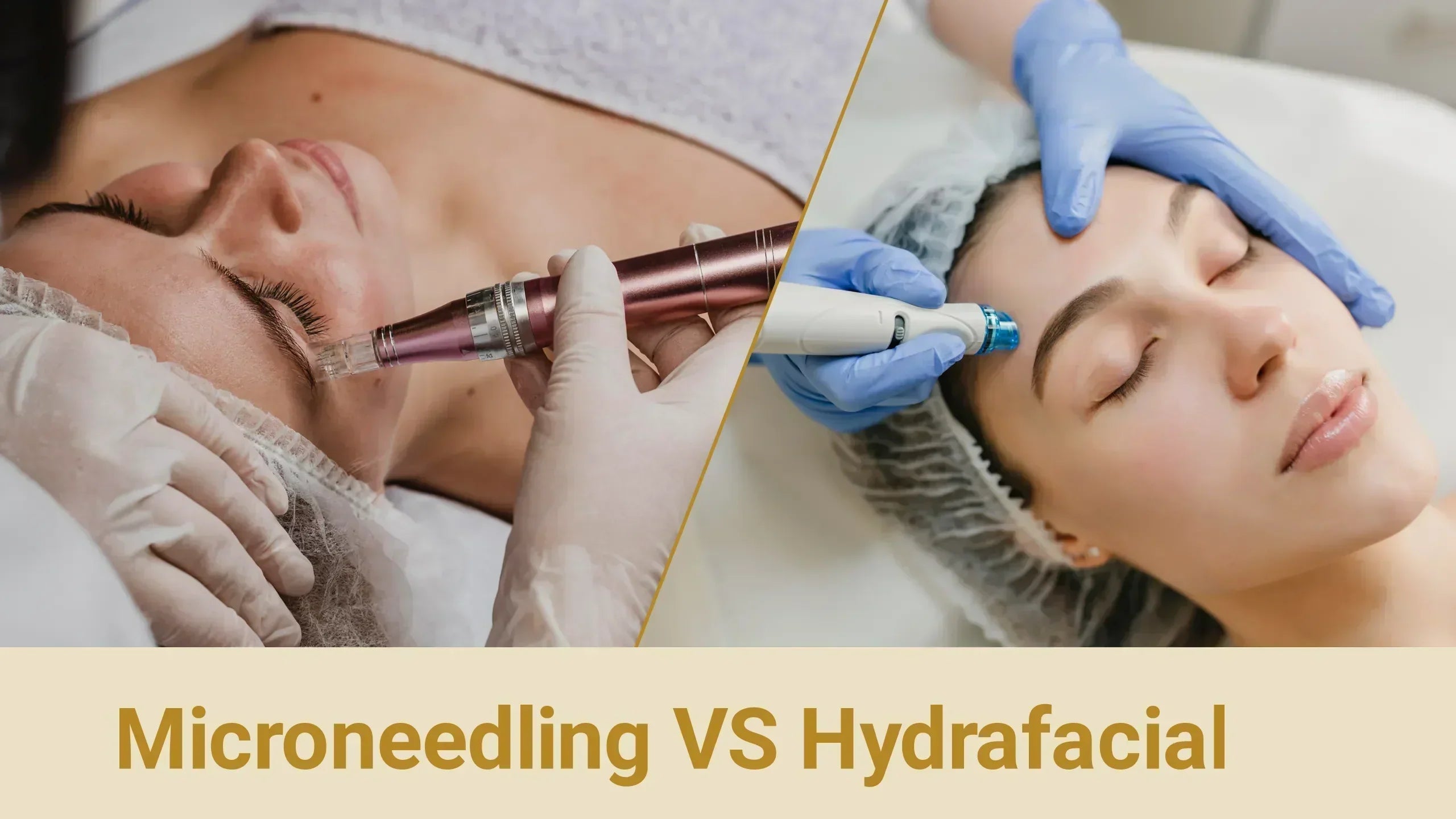A potent hydrating formula combining pure hyaluronic acid, vitamins, and repair factors to plump fine lines, strengthen skin structure, and restore radiance.

In today's ever-changing skincare world, two treatments have gained significant attention for those chasing clearer, smoother, and younger-looking skin: microneedling vs hydrafacial. Both aim to rejuvenate the skin but work in unique ways. So how do you choose between them?
Whether you're asking "What does a HydraFacial do?" or "Microneedling, what does it do?", this guide will break it all down. We'll cover what each treatment involves, what skin concerns they target, and how to decide which is best for your needs, or whether they might even work better together.
Let's start off with "what's a hydrafacial". A HydraFacial is a gentle treatment that cleans, exfoliates, and hydrates your skin in one session, leaving it fresh, smooth, and glowing. A hydrafacial after microneedling is generally known as a "power wash for your face."
The HydraFacial device utilizes unique technology to deliver active chemicals while also extracting debris. It's a gentle, non-irritating method that works for almost any skin type.
The customizable tips and solutions allow the treatment to be tailored to individual skin concerns, whether it's dryness, acne, fine lines, or dullness. Results are visible immediately, with no discomfort or downtime, making it a favorite for both beginners and skincare enthusiasts alike.
HydraFacials are ideal for people with dull skin, clogged pores, oily or acne-prone skin, and light pigmentation. If you're asking, "Is HydraFacial good for acne?" or "Does HydraFacial help with acne," the answer is yes. It's notably excellent at reducing congestion and increasing overall skin clarity.
Most people get a HydraFacial on average every 4 to 6 weeks. Each session takes about 30 to 45 minutes. You'll see a quick glow, but regular sessions keep the results going.
Microneedling, also known as collagen induction therapy in the medical world, uses fine needles to create micro-channels in the skin. This triggers natural collagen production, improving texture, firmness, and overall skin health. You can do it professionally or at home with a microneedling pen, like the advanced Dr. Pen microneedling devices.
Microneedling pens use tiny, quick-moving needles to poke the skin lightly. These small touches kickstart your body's natural healing, which helps boost collagen and elastin, the proteins that keep your skin firm and smooth. It's a simple way to help fade scars, soften lines, and give your skin a healthier, more refreshed look.
Devices like the Dr. Pen offer adjustable depth and speed options, allowing safe, targeted treatment for different skin types and concerns. Though slightly more intense than HydraFacial, microneedling addresses deeper concerns like wrinkles, scarring, and texture issues.
While results improve gradually, the boost in firmness, tone, and clarity can be impressive, especially when paired with the right serums and regular aftercare.
Those who have:
Downtime usually lasts 1 to 3 days. For best results, plan 3 to 6 sessions spaced 4 to 6 weeks apart. Improvements build gradually with each treatment.
When picking between hydrafacial vs microneedling, it's important to understand how each treatment works and what it's best for.
HydraFacial is a non-invasive facial that combines deep cleansing, gentle exfoliation, and strong hydration. It's a relaxing, spa-like treatment that works for all skin types, including sensitive and acne-prone skin. HydraFacial is effective in brightening dull skin, reducing blackheads, and increasing moisture.
It provides immediate effects with no downtime, making it ideal for events or as a routine maintenance facial. Most people receive it every 4 to 6 weeks to keep their skin healthy and balanced.
Microneedling uses tiny needles to gently trigger the skin's natural repair process, encouraging fresh collagen to form and helping the skin look firmer, smoother, and more refreshed.
It's a more intensive treatment that aims to improve texture, reduce acne scars, soften fine lines or wrinkles, and tighten the skin. Microneedling is acceptable for most skin types, although it works especially well on aged, scarred, or textured skin.
It involves some downtime, usually 1 to 3 days of redness or sensitivity, and the results are gradual over numerous sessions. Most people require 3 to 6 treatments spaced a month apart, with a few maintenance sessions per year.
While HydraFacial provides quick surface radiance, microneedling improves structural integrity over time. Your choice ultimately depends on your skin goals. Do you want a quick glow or a deeper, long-term improvement?
The best part? You can tailor the treatment to fit what your skin needs. Here's how it works:
With guidance from a skincare professional, you can alternate or space out HydraFacial and microneedling for complementary benefits. A HydraFacial can prep the skin for microneedling by clearing buildup, while microneedling can build collagen and tighten the skin afterward.
Whether you were wondering: "Do hydrafacials work?" or "Is Microneedling better for me?", it all depends on your skin goals. Whether you're seeking a quick, dewy glow or long-term rejuvenation, understanding your skin's needs will help you make the right choice.
Explore our selection of microneedling Dr. Pen devices and buy microneedling pen options designed for safe, professional-level treatments in the comfort of your own home.
Microneedling for All Skin Types
Struggling with uneven tone or texture? Discover how microneedling transforms all skin types - safely, gently, and with glowing results.
What Size Needles Do You Need for Micro Needling?
Not sure what microneedling needle size to use? Explore this complete guide to needle depths, treatment areas, and safe usage with Dr. Pen.
How To Choose Dr. Pen Microneedling Cartridges for Your Microneedling Treatment
Explore Dr. Pen cartridges by type, size & purpose. Find out which microneedle is best for your skin and why reusing isn’t safe.